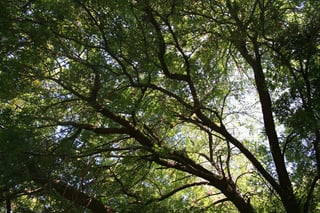 If you have ever driven through the streets of an old neighborhood you know how much impact a large shade tree can make. They tower amongst the houses blocking out the intense rays of sun from the yards and streets below. These urban giants have been growing in these locations sometimes over a hundred years.
If you have ever driven through the streets of an old neighborhood you know how much impact a large shade tree can make. They tower amongst the houses blocking out the intense rays of sun from the yards and streets below. These urban giants have been growing in these locations sometimes over a hundred years.
So how do we prepare our new neighborhoods to eventually look like the beautiful older neighborhoods we see? The answer is found in proper planning, proper care and of course, patience.
Soil & Moisture Conditions
When selecting a shade tree for your St. Louis landscaping that will sustain for years to come you must understand your site conditions. A water loving tree at the top of a hill isn’t a successful situation. When you think about your location you have to think about, soil & moisture conditions, sun and wind exposure, and the space available for a mature tree to spread.
Soil & moisture conditions are probably the most important aspect when selecting a tree.
 The soil is where the roots are and the roots are the foundation of the tree. When we look at soil moisture one the most important factors is how saturated the soil stays. You could have a site that has a lot of exposure to water but if that soil does not stay saturated that water could just be providing a good drink.
The soil is where the roots are and the roots are the foundation of the tree. When we look at soil moisture one the most important factors is how saturated the soil stays. You could have a site that has a lot of exposure to water but if that soil does not stay saturated that water could just be providing a good drink.
The structure of the soil is equally important. There are trees that thrive in all soil types; there are even some that don’t mind the heavy clay soils of St. Louis landscaping.
Determining your soil structure can be done by just digging up a sample of the area you want to plant the trees. Run the soil around in your hands and see how well it sticks together, if it is very dry you can add some water. The better the soil clod sticks together the more clay material is in your soil. The gritty material is the silt or sand. The higher the clay content the more moisture the soil will hold. Start by selecting a shade tree that grows well in your soil & moisture conditions.
Sun and Wind Exposure
 When selecting a shade tree sun & wind exposure is important for a few reasons. While most shade trees will prefer full sun, there are some that do better in part shade. This is beneficial because it allows you to have better success when under-planting an existing large tree, so you have a ready successor when the larger tree starts to decline.
When selecting a shade tree sun & wind exposure is important for a few reasons. While most shade trees will prefer full sun, there are some that do better in part shade. This is beneficial because it allows you to have better success when under-planting an existing large tree, so you have a ready successor when the larger tree starts to decline.
Wind exposure can be very important in selecting a tree. Some shade trees have tendency for breakage so an exposed site could cause a dangerous situation. Fast growing shade trees like Silver Maple and Cottonwood are commonly damaged in the heavy storms of St. Louis.
Selecting the Location
Maybe second most important to siting your tree in the right soil conditions is siting your tree in the right place. Shade trees come in all shapes, sizes, growth rates, etc. So make your tree fit your space instead of making your space fit your tree.
When you’re looking at what type of tree can fit your space you must consider its MATURE size. You want a specimen that can last for generations to come. I cringe when I hear someone say, “I don’t care how big it will be in 30 years, I won’t be here.” Plan to let the tree grow to its full capacity without obstructions from structures or wires. By doing so, you will pass on a gift that will outlast your lifetime!
Providing Tree Care
So you have your tree selected. Now it’s up to you to provide the care. This starts happening the second your St. Louis landscaping company installs it or you put it in the car at the nursery.
 If you are installing the tree yourself handle it with care. Take care not to drop the root ball or yank around aggressively on the trunk. This is a living plant which will live for tens of years!
If you are installing the tree yourself handle it with care. Take care not to drop the root ball or yank around aggressively on the trunk. This is a living plant which will live for tens of years!
As soon as the tree is transplanted it’s under stress. Remember, it’s just been ripped from its home and dropped into a new environment. Monitor the soil moisture by keeping the plant moist but not wet and provide mulch around it to buffer the temperatures.
Even a native tree is outside of its preferred native environment. They don’t prefer the sidewalk next to them or the kid that rams their bike against them. So provide extra care. The healthier you keep your tree in the early years the stronger it will be in the future.
Slow Growing Vs. Fast Growing St. Louis Shade Trees
The very last step is patience. A beautiful urban forest doesn’t happen overnight. When selecting a shade tree for your St. Louis landscaping I would highly recommend the slow growers such as:
- Bur Oak
- White Oak
But I know in our fast paced life everyone wants immediate gratification. There are some good fast growing shade trees that will work in our area including:
- Tulip Poplar
- Red Oak
- Zelkova
These are good selections that have a faster growth rate. As with any other plant selection always research and find what works best for you and your situation. Or you can call Dowco and have our team of educated professionals assist you in creating a landscape that can last for years to come!



